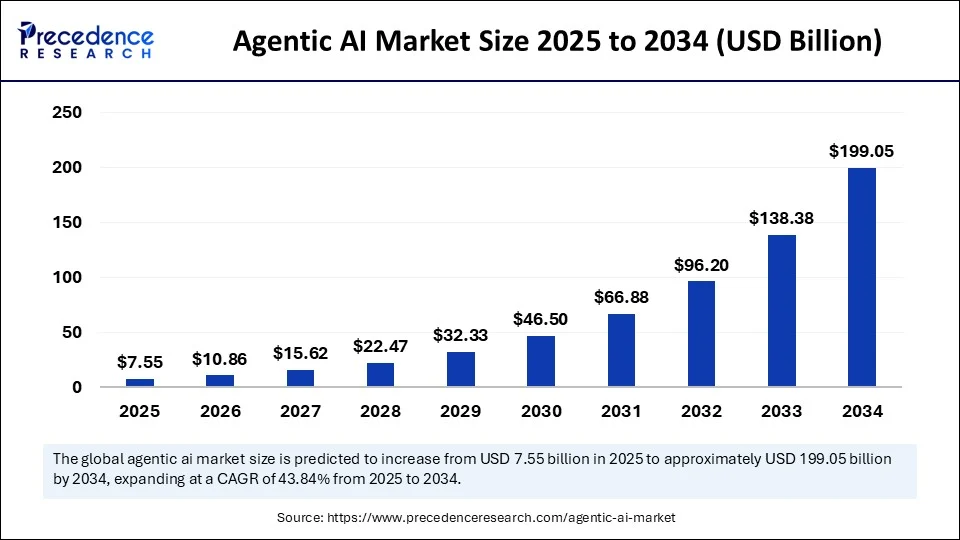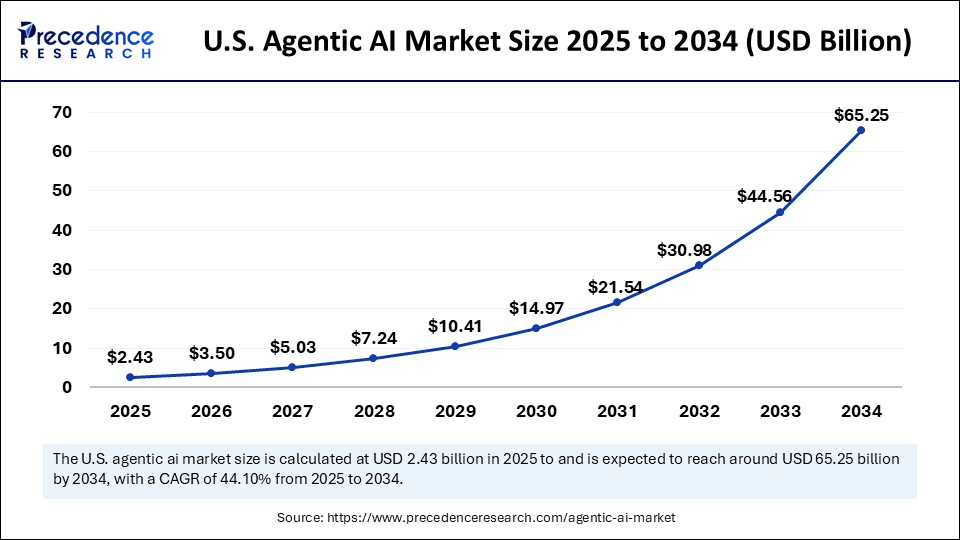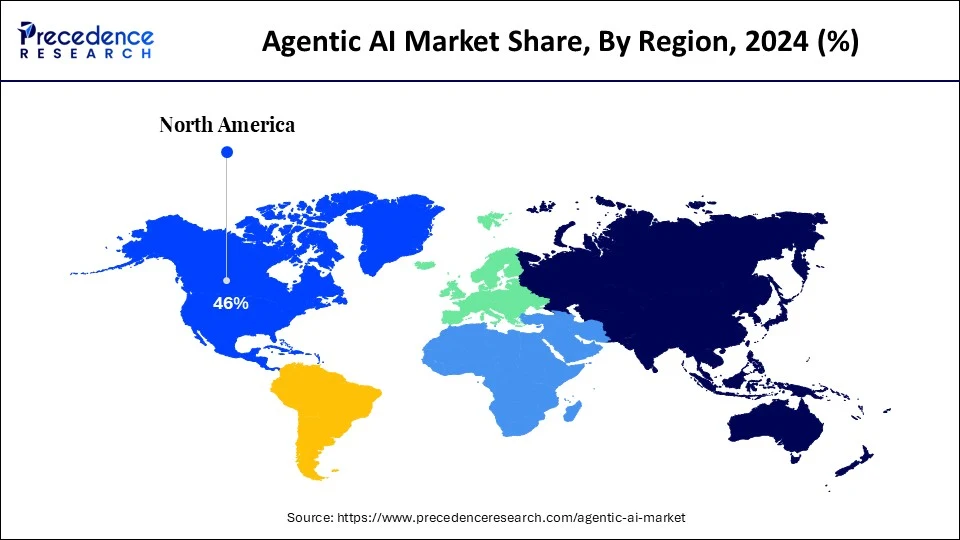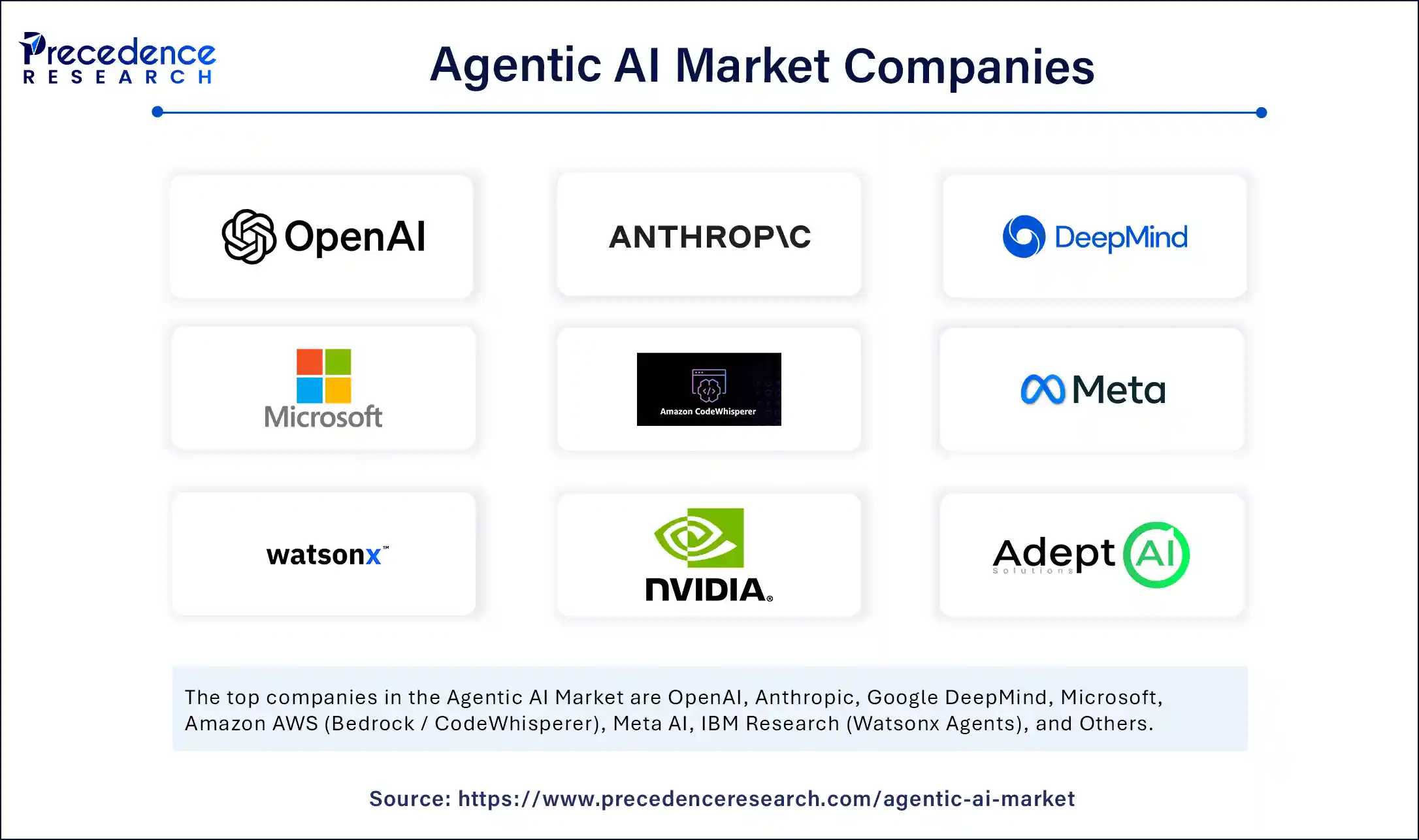What is the Agentic AI Market Size?
The global agentic AI market size is valued at USD 7.55 billion in 2025 and is predicted to increase from USD 10.86 billion in 2026 to approximately USD 199.05 billion by 2034, expanding at a CAGR of 43.84% from 2025 to 2034. The market is growing due to rapid integration of AI in various industries, such as finance, transport, defense, and healthcare, due to their ability to fully automate tasks without human interaction.

Agentic AI Market Key Takeaways
- In terms of revenue, the global agentic AI market was valued at USD 5.25 billion in 2024.
- It is projected to reach USD 199.05 billion by 2034.
- The market is expected to grow at a CAGR of 43.84% from 2025 to 2034.
- North America dominated the agentic AI market with the largest market share of 46% in 2024.
- Asia Pacific is expected to witness the fastest growth during the foreseeable period.
- By application domain, the cognitive agents (virtual assistants & co-pilots) segment held the biggest market share of 34% in 2024.
- By application domain, the autonomous systems segment is expected to witness the fastest growth during the forecast period.
- By technology stack, the learning and adaptation frameworks segment captured the highest market share of 29% in 2024.
- By technology stack, the planning and goal management engines segment is expected to grow at the fastest CAGR between 2025 and 2034.
- By end-use industry, the technology and software segment contributed the major market share of 38% in 2024.
- By end-use industry, the healthcare & life sciences segment is expected to expand at the fastest rate during the foreseeable period.
- By deployment mode, the cloud-based agentic AI segment accounted for the significant market share of 62% in 2024.
- By deployment mode, the hybrid architectures segment is expected to witness the fastest growth during the projection period.
- By intelligence level, the hybrid (BDI – belief-desire-intention) agents segment generated the major market share of 41% in 2024.
- By intelligence level, the deliberative agents segment is expected to witness the fastest growth in the coming years.
Strategic Overview of the Global Agentic AI Industry
Agentic AI refers to artificial intelligence systems that exhibit autonomous decision-making capabilities, goal-directed behaviour, and long-term planning like human agents. Unlike traditional AI, which reacts to specific inputs, agentic AI proactively initiates actions, adapts to new environments, and operates with a degree of self-governance. These systems are designed to understand goals, reason through complex tasks, learn from experience, and self-correct without requiring explicit instructions at every step. Applications span from autonomous robotics and intelligent assistants to dynamic process optimization in industrial and enterprise settings.
Artificial Intelligence: The Next Growth Catalyst in Agentic AI
| Feature | Agentic AI | Generative AI |
| Primary function | Goal-oriented action & decision-making | Content generation (text, code, images, etc.) |
| Autonomy | High: Operates with minimal human oversight | Variable: May require user prompts or guidance |
| Learning | Reinforced Learning: Improves through experience | Data-driven learning: Learns from existing data |
| Task complexity | High: Solves complex, multi-step problems | Moderate: Generates content but doesn't handle complex tasks autonomously |
What are the Key Trends in the Agentic AI Market?
- Automation in data pipelines: Organizations are scaling AI and analytics, which increases data pipeline complexity. To maintain high-quality data, AI agents are being integrated into pipelines to replace human-driven repair and monitoring. These agents, built with reinforcement learning and modular architectures, automatically monitor pipeline health, detect issues, diagnose problems, and repair them.
- Growing adoption in various sectors: AI agents are increasingly being used across sectors like customer service, healthcare, finance, and manufacturing, functioning as computer operators to provide instant service, understand context, and generate human-like responses. In healthcare, these agents manage processes like text analysis, medical billing, patient history, appointments, scheduling, and office administration. Additionally, AI agents automate computer tasks, including reminders and security monitoring.
- Increasing automation needs: The demand for automating complex tasks across industries is a major driver. Agentic AI can handle intricate processes, reducing the need for human involvement and improving efficiency.
Market Outlook:
- Market Growth Overview: The Agentic AI market is expected to grow significantly between 2025 and 2034, driven by continuous innovation in AI-specific processors, advancements in large language models and context-aware compounding are enabling the development and deployment of more sophisticated agents. Adoption of multi-agent systems, industry-specific solutions, and agent-as-a-service.
- Sustainability Trends: Sustainability trends involve addressing AI's environmental footprint, an emphasis on ethical and responsible AI, and governmental and research focus.
- Major Investors: Major investors in the market include Microsoft, Alphabet (Google & GV), Amazon (AWS), Nvidia, Salesforce Ventures, and Softbank Vision Fund.
- Startup Economy: The startup economy is focused on orchestration and tool use, niche specialization and vertical solutions, and leveraging cloud infrastructure.
Market Scope
| Report Coverage | Details |
| Market Size by 2034 | USD 199.05 Billion |
| Market Size in 2025 | USD 7.55 Billion |
| Market Size in 2026 | USD 10.86 Billion |
| Market Growth Rate from 2025 to 2034 | CAGR of 43.84% |
| Dominating Region | North America |
| Fastest Growing Region | Asia Pacific |
| Base Year | 2024 |
| Forecast Period | 2025 to 2034 |
| Segments Covered | Application Domain, Technology Stack, End-User Industry, Deployment Mode, Intelligence Level, and Region |
| Regions Covered | North America, Europe, Asia-Pacific, Latin America, and Middle East & Africa |
Market Dynamics
Drivers
Increasing shift toward open-source models
The growth of the agentic AI market is significantly driven by the growing preference for open-source models, contrasting with the proprietary models often controlled by major tech companies. An open-source model is favoured by business-to-business companies owing to their operational costs. This is highly applicable for open-source models such as Anthropic and MISTral. Smaller models are increasingly used for well-defined and specific tasks. Companies can easily fine-tune AI models to minimize over-dependency on substantial third-party APIs. Also, smaller and open-source models have the potential to be fine-tuned for specific business-related tasks, which is highly beneficial for developers to adopt new perspectives, expanding market growth.
Moreover, open-source models are accessible and customizable, allowing developers to adapt them for specific tasks, leading to diverse applications. This contrasts with proprietary models, which can be restrictive. The collaborative nature of open-source projects accelerates development, as developers worldwide contribute to improving and expanding the capabilities of these models. This, in turn, lowers the barrier to entry for businesses, encouraging wider adoption and driving market expansion.
Restraint
Over-dependency with the potential threat of job displacement
Despite having numerous benefits, over-dependency on agentic AI, coupled with the potential for job displacement, hinders market growth by creating several challenges. Public and governmental apprehension regarding job security can lead to stricter regulations and reduced investment in agentic AI technologies. The need for retraining and workforce adaptation also adds to the cost and complexity of implementation. Moreover, ethical concerns about fairness and bias in AI systems can erode public trust, further slowing market expansion. Therefore, addressing these issues through responsible development, transparent practices, and proactive workforce strategies is crucial for sustainable growth in the agentic AI market.
Opportunity
How will AI agents help connect with the physical world?
A significant opportunity for the market lies in the integration of AI agents with the physical world. AI agents are increasingly being deployed with Internet of Things (IoT) devices and physical world environments, such as homes and offices, where AI agents can work without human intervention. A real-world example includes collaborations between tech giants like NVIDIA and GE Healthcare on agentic robotic systems for X-ray and ultrasound technologies. These AI agents analyze medical imaging and interact with the physical world, creating lucrative opportunities for substantial market growth in the foreseeable future.
Application Domain Insights
Why did the cognitive agents segment dominate the agentic AI market in 2024?
The cognitive agents (virtual assistants & co-pilots) segment dominated the market with the largest market share of 34% in 2024. This dominance stems from their ability to make autonomous decisions without human interaction, thereby reducing human workload. Designed to mimic human cognitive processes, these agents utilize reasoning, logic, and decision-making based on existing data to execute tasks with precise planning. This makes cognitive agents widely applicable in customer relationship management, enterprise resource planning, and supply chain management.
The autonomous systems segment is expected to witness the fastest growth during the forecast period. This is primarily due to its increasing recognition across various industries for its ability to manage complex situations with minimal human interaction, thereby boosting efficiency. Another key driver for the segment's growth is the development of advanced foundation models like GPT-4, Gemini, and Claude, which facilitate the sophisticated building of AI agents.
Technology Stack Insights
How does the learning & adaptation frameworks segment lead the Agentic AI market?
The learning & adaptation frameworks segment led the market while holding the largest share of 29% in 2024. Learning and adaptation frameworks are crucial because they enable AI agents to make data-driven decisions and enhance their performance over time, allowing them to operate effectively in complex environments across various industries. These frameworks are essential for building effective and scalable AI agent systems. Machine learning and deep learning are prime examples of these frameworks, increasingly used to build AI agents applicable in smart cities, manufacturing and logistics hubs, healthcare, and the financial sector, thereby enhancing their capabilities.
The planning & goal management engines segment is expected to grow at the fastest CAGR during the projection period. This growth is driven by factors such as complex task automation, workflow optimization, and a goal-oriented approach that enhances Return on Investment (ROI). This is made possible through the integration of technologies like Large Language Models (LLMs), Robotic Process Automation (RPA), and autonomous tool orchestration, resulting in highly adaptive and goal-oriented systems.
End-Use Industry Insights
What made technology & software the dominant segment in the market?
The technology & software segment dominated the agentic AI market with the largest market share of 38% in 2024. This dominance is attributed to the direct impact of AI agents on automating tasks like code generation, bug finding, and optimization, which accelerates development cycles and reduces costs. The technology & software sector provides essential tools, frameworks, and platforms for building and deploying agentic AI systems, contributing significantly to its growth. Moreover, the potential of agentic AI to create new business models and expand offerings across various sectors, aligning with consumer expectations, is a key driver for this segment's expansion.
Moreover, agentic AI is widely used in tech and software development for intelligent process automation, software testing, and customer support. The segment's growth is fueled by the need for efficient, scalable solutions, with companies using Agentic AI to automate tasks, improve decision-making, and enhance customer experiences.
The healthcare & life sciences segment is expected to witness the fastest growth over the forecast period, driven by agentic AI's capacity to cut costs and reduce staff burnout through automation. This technology streamlines administrative tasks and optimizes resource allocation. Furthermore, Agentic AI accelerates drug discovery by offering quick, precise simulations, which directly address the time-consuming and intricate processes inherent in traditional methods.
Deployment Mode Insights
Why did the cloud-based agentic AI segment dominate the market in 2024?
The cloud-based agentic AI segment dominated the agentic AI market, holding the largest market share of 62% in 2024, thanks to its scalability and flexibility. Cloud deployment enhances collaboration, accessibility, and focus on core business processes. Cloud providers handle infrastructure complexities, allowing businesses to concentrate on innovative AI solutions. These platforms also facilitate data sharing and knowledge management, boosting overall efficiency for Agentic AI deployments.
The hybrid architectures segment is expected to expand at a significant CAGR in the upcoming period. This is mainly due to its flexible method of controlling the distribution of the workspace, which allows for tailoring tasks and forwarding others to autonomous systems. This is highly effective for time-sensitive and mission-critical tasks, ensuring high consistency.
Intelligence Level Insights
How does the hybrid (BDI) agents segment dominate the agentic AI market?
The hybrid agents segment dominated the market with the largest share of 41% in 2024. This dominance is due to its combination of traditional programming with large language models, enabling precise execution and thoughtful decision-making. It allows for security protocols and calculations to be handled by conventional programming while leveraging LLMs for adaptability and dynamic responses, showcasing its ability to handle a diverse array of tasks.
The deliberative agents segment is expected to witness the fastest growth during the foreseeable period of 2025-2034. The growth of the segment is driven by their sophisticated decision-making capabilities, which involve analyzing options, assessing potential outcomes, and selecting the best actions for complex tasks. This approach makes them highly applicable in real-world applications such as supply chain management, finance, healthcare, and smart home systems.
Regional Insights
U.S. Agentic AI Market Size and Growth 2025 to 2034
The U.S. agentic AI market size is exhibited at USD 2.43 billion in 2025 and is projected to be worth around USD 65.25 billion by 2034, growing at a CAGR of 44.10% from 2025 to 2034.

What made North America the dominant region in the agentic AI market?
North America dominated the agentic AI market by holding the largest market share of 46% in 2024. This is mainly due to its robust technology landscape and significant investments in agentic AI systems across industries like finance, healthcare, retail, and telecom. AI agents are used for task automation and customer service. The U.S. government is also promoting agentic AI for defense and security applications, providing intelligence support for critical tasks. Moreover, increased investment in AI research and development is fueling innovation and market expansion.
- For instance, in July 2025, the Pentagon unveiled that it has selected xAI, Google, anthropic, and Open AI to support U.S. military tasks with the help of artificial intelligence. And each enterprise has received a contract of USD 200 million as per the chief digital and AI office.
(Source: https://www.defensenews.com)
North America: U.S. Agentic AI Market Trends
The U.S. market is experiencing significant growth, driven by a shift from simple automation to autonomous, multi-agent systems that learn and adapt. The integration of AI agents into core enterprise platforms and the rise of specialized, industry-specific solutions in sectors like BFSI and healthcare.

What factors are influencing the growth of the agentic AI market in Asia Pacific?
Asia Pacific is expected to witness the fastest growth during the foreseeable period of 2025-2034. This growth is driven by the region's increasing digital infrastructure and government support for AI development across countries like India, China, and Japan. Start-ups and tech giants such as Alibaba, Baidu, and Tencent are developing their own AI environments supported by AI agents. Regional start-ups are implementing AI agents in various domains such as healthcare, finance, transportation, and smart city projects, further accelerating the regional market growth.
Rising digitalization in the financial sector opens up new growth avenues for market expansion in the region. Agentic AI can be used for fraud detection, risk management, and algorithmic trading, offering significant opportunities in the financial sector. Moreover, the development of smart cities contributes to market growth. Agentic AI can be integrated into smart city infrastructure for traffic management, energy optimization, and public safety.
Asia Pacific: China Agentic AI Market Trends
China's market is poised for rapid expansion, driven by proactive government support, a vast data pool, and the aggressive development of domestic models by tech giants. The focus on commercialization and practical applications across sectors, including e-commerce, finance, and manufacturing.
Europe Emerges as a Strategic Powerhouse in the Agentic AI Revolution
Europe is witnessing notable growth in the market as enterprises accelerate automation initiatives to enhance productivity and reduce operational complexity. Strong regulatory frameworks such as the EU AI Act are encouraging responsible development, driving demand for transparent, explainable, and compliant AI agents. Increased investment in AI research hubs across Germany, France, and the Nordics is fostering innovation and adoption of autonomous workflows.
Germany Agentic AI Market Trends
Germany's market is driven by its robust integration with the country's Industry 4.0 initiatives, prioritizing specialized applications for the manufacturing, automotive, and financial sectors. Strong emphasis on trusted AI and is shaped by EU regulations, particularly the EU AI Act, which drives a focus on ethical, transparent, and secure systems.
Value Chain Analysis of the Agentic AI Market
- Infrastructure and Foundational Models
This foundational stage involves developing and providing the essential hardware (AI chips, high-performance computing) and the large language models (LLMs) that power AI agents.
Key Players: NVIDIA (hardware), Google, Microsoft (Azure AI), and Amazon Web Services (AWS) - Agent Development and Orchestration Platforms
This stage involves creating the frameworks, tools, and platforms that developers use to design, build, test, and deploy AI agents and manage how they interact with each other and existing systems.
Key Players: LangChain, AutoGPT, Hugging, Microsoft and Google. - Application Development and Integration
This stage focuses on building specific, targeted AI agent applications and seamlessly integrating them into existing enterprise software, workflows, and industry-specific processes.
Key Players: CRM and ERP systems like Salesforce and SAP, and service firms like Accenture and IBM, which customize and integrate solutions. - Distribution and Sales
This stage involves the marketing, selling, and distribution of agentic AI solutions to end-user businesses and consumers. Distribution often occurs through cloud marketplaces, direct sales teams, and partnerships with system integrators.
Key Players: AWS Marketplace, Microsoft AppSource, and direct sales teams from companies like Google and OpenAI facilitate market reach.
Top Companies in the Agentic AI Market & Their Offerings:
- OpenAI: OpenAI provides advanced models like GPT-4o that power many AI agents. Their tools help developers create and deploy sophisticated agents.
- Anthropic: Anthropic's "Claude" models are used to build enterprise-grade agentic systems. Their focus on constitutional AI helps agents adhere to specific guidelines.
- Google DeepMind: Google DeepMind develops models like Gemini to enhance agentic capabilities. Their Google Cloud AI solutions facilitate practical agent deployment.
- Microsoft: Microsoft integrates AI agents into its products like Azure AI and Microsoft 365, making autonomous AI features accessible to many users. This helps with enterprise adoption and development.
- Amazon AWS (Bedrock / CodeWhisperer): Amazon Web Services provides Bedrock, a service offering access to models from leading AI companies to build generative AI applications and agents. Amazon CodeWhisperer assists developers in writing code, using agentic principles to automate and optimize the software development process.
- Meta AI: Meta AI focuses on open-source AI research and models like Llama 3, which provides a flexible foundation for building custom AI agents. This open approach accelerates innovation.
- IBM Research (Watsonx Agents): IBM develops the Watsonx platform, focusing on trusted AI agents for business operations. Their solutions target regulated industries where reliability and compliance are important.
- NVIDIA: NVIDIA provides the GPU hardware and software platforms needed for training and deploying large-scale AI models and autonomous agents. The company's technology is essential for complex agentic systems.
- Adept AI: Adept AI builds agents that automate complex workflows within enterprise environments. Their technology aims to create "action models" that learn how to use digital tools on a user's behalf.
- Inflexion AI: Inflexion AI develops conversational agents that focus on personalized, empathetic interactions. Their work advances human-computer interaction.
- Reka AI: Reka AI develops multi-modal language models that enable agents to understand and reason across text, images, and video. This research expands agent capabilities.
- Cohere: Cohere focuses on enterprise-grade language models and retrieval-augmented generation (RAG) capabilities, which are essential for building AI agents. They provide tools tailored for business needs.
- Hugging Face: Hugging Face provides a repository of open-source models, datasets, and tools, enabling the development and sharing of various AI agents. This fosters rapid innovation.
- Mistral AI: Mistral AI develops open-source language models that provide alternatives for building customized AI agents. This approach democratizes access to high-performance AI.
- Figure AI: Figure AI integrates AI agents with advanced robotics to create humanoids that can operate in real-world environments. This expands AI automation into physical tasks.
- Covariant: Covariant develops the "Covariant Brain" platform for industrial robots to autonomously work in warehouse environments. Their technology focuses on automating fulfillment and logistics.
- Sanctuary AI: Sanctuary AI develops general-purpose robots powered by AI control systems. They aim to create AI agents that adapt to different work environments.
- Siemens (Agentic Industrial AI Systems): Siemens integrates AI agents into industrial automation systems to improve manufacturing processes. Their focus is on improving efficiency in industrial settings.
- Palantir Technologies: Palantir applies its data integration platforms to create agentic AI systems for complex data analysis. Their technology is used for high-stakes applications.
- Runway ML: Runway ML provides AI-powered video generation and editing tools that leverage agentic principles to automate creative tasks. Their platform streamlines multimedia production.
Agentic AI Market Companies

- OpenAI
- Anthropic
- Google DeepMind
- Microsoft
- Amazon AWS (Bedrock / CodeWhisperer)
- Meta AI
- IBM Research (Watsonx Agents)
- NVIDIA
- Adept AI
- Inflection AI
- Reka AI
- Cohere
- Hugging Face
- Mistral AI
- Figure AI
- Covariant
- Sanctuary AI
- Siemens (Agentic Industrial AI Systems)
- Palantir Technologies
- Runway ML
Recent Developments
- In June 2025, Accenture introduced AI Refinery distiller agentic framework and accompanying software development kits (SDKs), offering developers an enterprise-grade platform to rapidly build, deploy, and scale advanced AI agents.(Source: https://newsroom.accenture.com)
- In March 2025, leading tech giants, Oracle and NVIDIA joined forces to help organizations worldwide speed the creation of agentic AI applications. The new integration between Oracle Cloud Infrastructure (OCI) and the NVIDIA AI Enterprise software platform will make 160+ AI tools and 100+ NVIDIA NIM™ microservices natively available through the OCI Console.(Source: https://www.oracle.com)
Segments Covered in the Report
By Application Domain
- Autonomous Systems
- Robotics
- Self-driving Vehicles
- Drones
- Others
- Cognitive Agents
- Virtual Assistants (e.g., AI Co-Pilots)
- Autonomous Decision Support Tools
- Adaptive Learning Systems
- Others
- Enterprise Process Agents
- AI for Business Process Automation
- Supply Chain Optimization
- Financial Modeling Agents
- Others
- Scientific & Research Agents
- Drug Discovery Agents
- Materials Design AI
- Scientific Simulators
- Others
By Technology Stack
- Planning and Goal Management Engines
- Reactive Planners
- Long-Term Planning Systems
- Others
- Cognitive Architectures
- Symbolic-Connectionist Models
- Neuromorphic Architectures
- Modular Reasoning Systems
- Others
- Autonomous Execution Platforms
- AI Agents for Multi-Agent Systems (MAS)
- Digital Twin-Integrated Agents
- Robotics OS with Agentic Capabilities
- Others
- Learning and Adaptation Frameworks
- Reinforcement Learning
- Imitation Learning
- Self-Supervised Learning
- Others
By End-User Industry
- Healthcare & Life Sciences
- AI Research Assistants
- Diagnostics & Workflow Agents
- Therapeutic Planning Agents
- Finance & Banking
- Investment Decision Agents
- Risk & Fraud Detection
- Autonomous Compliance Tools
- Manufacturing & Logistics
- Autonomous Planning Agents
- Process Optimization
- Supply Chain Agents
- Defense & Aerospace
- Tactical Decision-Making Agents
- Reconnaissance & Surveillance AI
- Technology & Software
- AI Development Platforms
- Autonomous Coding Agents
- Copilot Tools
- Education & Training
- Adaptive Learning Agents
- Personal Tutoring Systems
- Others
- Smart Cities
- Retail & eCommerce
- Agriculture & Environment
By Deployment Mode
- On-Premises Agentic Systems
- Cloud-Based Agentic AI
- Hybrid Architectures
By Intelligence Level
- Reactive Agents
- Deliberative Agents
- Hybrid (BDI – Belief-Desire-Intention) Agents
By Region
- North America
- Europe
- Asia Pacific
- Latin America
- Middle East & Africa
For inquiries regarding discounts, bulk purchases, or customization requests, please contact us at sales@precedenceresearch.com
Frequently Asked Questions
Ask For Sample
No cookie-cutter, only authentic analysis – take the 1st step to become a Precedence Research client
 sales@precedenceresearch.com
sales@precedenceresearch.com
 +1 804-441-9344
+1 804-441-9344